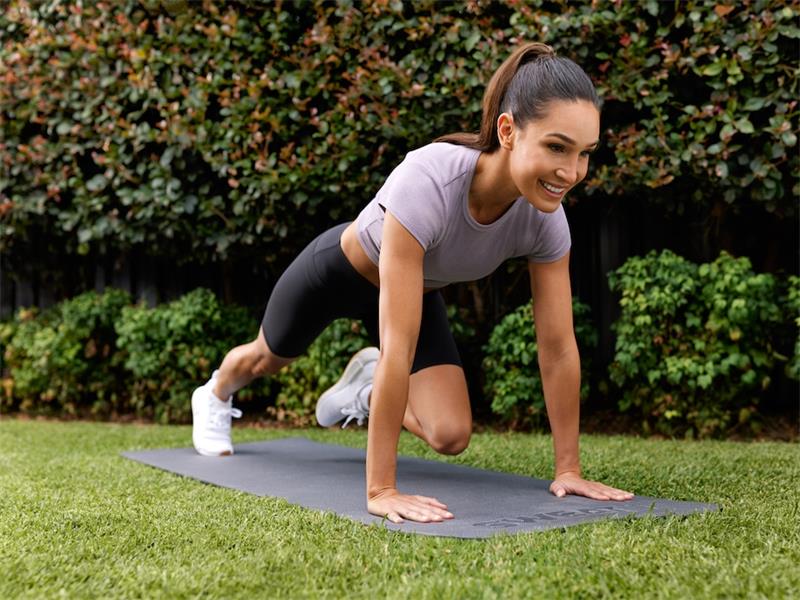Contents
- 1 The Importance of Cardio Workouts for Overall Health and Fitness
- 2 The Benefits of High-Intensity Interval Training (HIIT)
- 3 What is High-Intensity Interval Training?
- 4 Sample High-Intensity Interval Training Workout Routine
- 5 The Benefits of Running for Cardiovascular Health
- 6 Tips for Beginners and Advanced Runners
- 7 Cycling: A Great Cardiovascular Workout
- 8 The Fun and Effective Jump Rope Workouts
- 9 The Benefits of Swimming for Cardiovascular Health
- 10 Different Swimming Strokes to Try
- 11 Stair Climbing: Taking The Stairs To A Healthier Heart
- 12 Rowing Machine Workouts
- 13 Dancing Workouts
- 14 Circuit Training Workouts
- 15 Conclusion
The Importance of Cardio Workouts for Overall Health and Fitness
Whether your goal is to improve your overall health, lose weight, or build endurance, cardio workouts are an essential part of any fitness routine. As the name suggests, cardiovascular exercise is designed to get your heart pumping and increase blood flow throughout the body.
This type of exercise helps improve heart health, boost metabolism, increase energy levels and reduce stress. Cardiovascular exercises range from low-impact options such as walking or cycling to high-intensity workouts such as sprinting or jumping jacks.
Regardless of your fitness level or preferences, there’s a cardio workout out there for everyone. One of the main benefits of cardio workouts is that they help improve heart health by increasing blood circulation throughout the body.
Over time, this can lead to improved cardiovascular function and a reduced risk of diseases such as high blood pressure or heart disease. Additionally, regular cardio exercise has been shown to boost metabolism and help you burn calories more efficiently – making it an essential tool for anyone looking to lose weight or maintain healthy body composition.
So whether you’re just starting out on your fitness journey or looking for new ways to challenge yourself in the gym, incorporating regular cardio workouts into your routine is one of the best things you can do for your overall health and well-being. From running and cycling to swimming and dancing – there are countless ways to get your heart pumping and enjoy all the benefits that come with a healthy cardiovascular system.
The Benefits of High-Intensity Interval Training (HIIT)
When it comes to cardio workouts, high-intensity interval training (HIIT) is the way to go. HIIT is a type of workout that involves quick bursts of intense exercise followed by short periods of rest or recovery.
This type of training is great for cardiovascular health because it gets your heart rate up and keeps it there, which can help improve your endurance over time. One of the biggest benefits of HIIT is that it can be done in a relatively short amount of time.
Because you are working at such a high intensity, you don’t need to spend hours in the gym to see results. In fact, just 15-20 minutes of HIIT can be as effective as an hour-long steady-state cardio workout.
Another benefit of HIIT is that it can help increase your metabolism and burn more calories throughout the day. This is because HIIT workouts create an “afterburn” effect, where your body continues to burn calories even after your workout has ended.
What is High-Intensity Interval Training?
So how does HIIT actually work? It’s simple: you perform short bursts of high-intensity exercise followed by periods of rest or recovery. For example, you might sprint for 30 seconds and then walk for 60 seconds before sprinting again.
You repeat this cycle for several rounds until your workout is complete. The key with HIIT is to really push yourself during the high-intensity portions.
This means going all out and giving it everything you’ve got for those 30 seconds or so. It may be challenging at first, but as you build up your endurance, you’ll find that you’re able to push harder and harder each time.
Sample High-Intensity Interval Training Workout Routine
Ready to try a HIIT workout? Here’s a sample routine to get you started:
1. Warm up for 5-10 minutes with light cardio like jogging or jumping jacks.
2. Perform 30 seconds of high-intensity exercise (like sprinting or burpees).
3. Rest for 60 seconds.
4. Repeat steps 2 and 3 for a total of 10 rounds.
5. Cool down with 5-10 minutes of light cardio and stretching. Remember, the key to a successful HIIT workout is to really push yourself during the high-intensity portions.
If you’re not feeling challenged, try increasing the intensity or duration of your intervals. And as always, be sure to listen to your body and take rest breaks as needed.
The Benefits of Running for Cardiovascular Health
Running is one of the most popular and effective cardio workouts you can do, and it offers a wide range of benefits for your cardiovascular health. Regular running can help improve your heart and lung function, increase your endurance, reduce the risk of chronic diseases, and even boost your mental well-being.
One of the primary benefits of running is its ability to improve cardiovascular health. When you run, your heart rate increases, which strengthens your heart muscle and improves its ability to pump blood throughout your body.
This increased blood flow helps deliver oxygen and nutrients to all parts of your body more efficiently, which can help reduce the risk of high blood pressure, heart disease, stroke, and other chronic illnesses. In addition to improving cardiovascular health, running also offers a range of mental health benefits.
Studies have shown that regular exercise like running can help reduce symptoms of depression and anxiety by boosting feel-good chemicals in the brain like endorphins and serotonin. Plus, setting achievable goals with running can give you a sense of accomplishment that boosts self-esteem.
Tips for Beginners and Advanced Runners
Whether you’re just starting out or have been running for years, there are always ways to improve your technique and get more out of your workouts. For beginners just starting out with running as a cardio workout routine: – Start slow: Don’t push yourself too hard too soon; gradually increase intensity over time.
– Invest in proper gear: Get fitted for shoes that support your feet properly; wear breathable clothing suitable for weather conditions – Mix up workouts: Alternate between walk/run intervals or incorporate hill sprints
– Set realistic goals: Start small (5K race) then work towards bigger races (marathon) Advanced runners looking to optimize their performance:
– Increase speed training days: Incorporate tempo runs or track repeats – Add strength training: Strengthening key muscle groups can improve running form and prevent injury
– Cross-train: Incorporate other workouts like swimming or cycling to reduce the risk of overuse injuries – Stretch: Incorporate a stretching routine into your workouts to improve flexibility and prevent muscle soreness.
Cycling: A Great Cardiovascular Workout
Cycling is an excellent low-impact activity that can give your cardiovascular system a great workout while allowing you to enjoy the outdoors. Whether you prefer mountain biking trails or leisurely rides in the park, cycling provides numerous benefits for your heart and overall health.
Benefits of Cycling for Cardiovascular Health
Cycling is a great exercise for improving cardiovascular health. Regular cycling can help improve heart function, reduce blood pressure, and lower the risk of heart disease and stroke. It can also increase lung capacity and improve oxygen uptake, which leads to better endurance overall.
Cycling is also an excellent way to strengthen leg muscles and core muscles. Stronger legs can help you climb hills more easily while core strength helps with balance and stability on the bike.
Types of Cycling Workouts
There are many different types of cycling workouts that you can try depending on your preference and fitness level. Indoor cycling classes are a great place to start if you’re new to cycling or want to improve your skills in a supportive environment. These classes typically involve riding stationary bikes while following along with an instructor who guides you through various resistance levels and speeds.
Outdoor cycling offers the benefits of fresh air, scenery, and varied terrain. You can ride solo or with a group on streets or trails depending on your preference.
Mountain biking adds an additional challenge as riders navigate rougher terrain with obstacles like rocks, roots, and jumps. Regardless of which type of cycling workout you choose, it’s important to wear appropriate safety gear like helmets and reflective clothing when riding outdoors.
It’s also essential to properly adjust your bike for comfort and efficiency so that you get the most out of your workout without risking injury. Whether you prefer indoor or outdoor cycling workouts or even mountain biking adventures, incorporating regular cardio exercise through cycling into your fitness routine offers numerous benefits for your heart and overall health.
The Fun and Effective Jump Rope Workouts
Jump rope workouts have been a popular form of exercise for years and for good reason. This simple yet effective workout can pack a big punch when it comes to getting your heart rate up and improving overall cardiovascular health. Here are some of the amazing benefits of jump rope workouts, along with different techniques to try.
Benefits of Jump Rope Workouts for Cardiovascular Health
Jumping rope is an excellent way to get your heart pumping and improve cardiovascular health. The constant jumping motion increases your heart rate, which in turn strengthens your heart muscle. Additionally, jump rope workouts can improve lung capacity and circulation throughout the body.
Jumping rope also burns a lot of calories in a short amount of time, making it an excellent option for those looking to lose weight or maintain a healthy weight. It’s also low-impact, which means it’s easier on the joints than other high-impact exercises like running.
Different Jump Rope Techniques to Try
If you’re new to jump rope workouts, start with basic jumps and work your way up from there. Basic jumps involve jumping with both feet together while swinging the rope under your feet and over your head. Once you’ve mastered basic jumps, try incorporating different techniques like single-leg jumps or double unders (jumping twice in one swing of the rope).
You can also add in cross-over jumps or side-to-side jumps for more variety. To get even more out of your jump rope workout, consider incorporating interval training by alternating between periods of high-intensity jumping and periods of lower-intensity rest.
This will not only increase the cardiovascular benefits but also challenge you mentally as well. Jump rope workouts are an effective and fun way to improve cardiovascular health while burning calories at the same time.
Don’t be afraid to mix things up by trying different techniques or incorporating interval training into your routine. And most importantly, have fun with it!
The Benefits of Swimming for Cardiovascular Health
Swimming is one of the best cardiovascular exercises you can do. It’s low-impact, so it’s perfect for people who have joint pain or are recovering from an injury. Swimming also uses every muscle in your body, making it a full-body workout that will help you burn calories and build strength.
Swimming improves cardiovascular health by increasing your heart rate and breathing rate. When you swim, your heart has to work harder to supply oxygen-rich blood to your muscles.
This increased demand for oxygen strengthens the heart over time and makes it more efficient at pumping blood throughout the body. Swimming also improves lung function by increasing lung capacity and improving breathing technique.
Different Swimming Strokes to Try
If you’re new to swimming, start with the freestyle stroke (also known as the front crawl). This stroke is the most efficient and easiest on the body, making it perfect for beginners.
To perform this stroke, kick your legs in a fluttering motion while simultaneously pulling yourself through the water with alternating arm strokes. Once you’ve mastered freestyle, try other swimming strokes like breaststroke, backstroke, and butterfly.
Breaststroke is great for toning your chest and arm muscles while backstroke targets your back muscles. The butterfly is considered one of the most challenging swimming strokes but can give you an intense workout that will leave you feeling accomplished.
Swimming is a fantastic way to improve cardiovascular health while also getting a full-body workout that targets every muscle group in your body. Whether you’re new to swimming or an experienced swimmer looking for a new challenge, there are many different swimming strokes to try that will keep you engaged and motivated in reaching your fitness goals!
Stair Climbing: Taking The Stairs To A Healthier Heart
Who would have thought that a simple activity like climbing the stairs can make a significant difference in one’s cardiovascular health? Stair climbing is an effective workout that gets your heart rate up, burns calories, and strengthens your muscles.
It’s also easy to do, inexpensive, and accessible since most buildings have stairs. One of the main benefits of stair climbing is its positive impact on cardiovascular health.
Regular stair-climbing workouts can increase your heart rate, resulting in improved blood circulation and oxygen supply throughout the body. Additionally, stair climbing is an effective workout for burning calories as it engages several muscle groups simultaneously.
According to research, a person weighing 160 pounds can burn about 150 calories by climbing stairs for only 10 minutes. If you’re new to stair climbing or haven’t done it before, start slowly by taking one flight at a time and gradually increasing the number of flights or steps you climb over time.
Remember to warm up before starting any exercise routine by stretching your legs and ankles. Start by walking up the first few flights of stairs before picking up your pace to jog or run up them.
Here are some tips on how to incorporate stair climbing into your workout routine: – Use the stairs instead of elevators whenever possible.
– Incorporate stair running intervals into your regular running routine. – Find outdoor stairs in public parks or stadiums for variety.
– Use a step platform if you prefer indoor workouts. Incorporating stair-climbing into your daily routine may seem daunting at first, but it’s an excellent way to improve heart health while toning leg muscles.
Start slow and work towards gradually increasing the intensity level over time until you’re regularly jogging or running up multiple flights without stopping. Not only will you feel better physically, but also mentally as endorphins are released during exercise making us feel happier overall.
Rowing Machine Workouts
The Benefits of Rowing Machine Workouts for Cardiovascular Health
Rowing is an excellent form of cardio that can help improve your overall cardiovascular health. Using a rowing machine can provide several benefits, such as improving your stamina and endurance, strengthening your muscles, and burning calories. Rowing also reduces the risk of heart disease by promoting healthy blood flow and lower blood pressure.
One of the advantages of using a rowing machine is that it exercises multiple muscle groups at once. It predominantly works your upper body muscles like biceps, triceps, shoulders, and chest while also targeting your back and core muscles to maintain balance while performing the exercise.
Regular use of this machine will increase muscular strength and endurance throughout your entire body. Another great aspect about using a rower is that it’s a low-impact exercise as it places little strain on joints compared to other cardio machines like treadmills or stair climbers which are high-impact exercises.
Sample Rowing Machine Workout Routine
A basic rowing workout involves intervals consisting of timed rows at a high intensity followed by rest periods. Start with a five-minute warm-up at an easy pace to prepare for the workout ahead.
For the main workout, complete four rounds with 20 seconds of intense rowing against resistance followed by 10 seconds of rest in between each round. After finishing all rounds take two minutes for recovery before starting the next set.
Repeat for five rounds Cooldown after completing all sets with low-intensity row under tension(Pull lightly) for five minutes to loosen up stiff joints
Here’s how you can make this routine more challenging:
Increase the resistance level on the machine gradually as you progress with each repetition Increase speed on intense phases
Decrease rest time between each round Incorporate longer duration reps
Remember to keep good form throughout the workout, as it’s easy to slip out of proper technique when fatigued. By using a rowing machine regularly, you’ll improve your cardiovascular fitness, strengthen your muscles, and boost your overall health.
Dancing Workouts
The Power of Dance
Dancing is an excellent way to keep your heart healthy, as it is a combination of aerobic exercise and rhythmic movements. It helps in strengthening your cardiovascular system, which includes the lungs and heart.
When you dance, it increases your heart rate and oxygen consumption, making your body work harder than usual. It also helps in improving coordination skills, balance, flexibility, and overall body fitness.
Different types of dance workouts to try
There are many different types of dance workouts that you can try depending on your preference and level of fitness. Here are some popular ones:
Zumba: A high-energy dance workout that combines Latin music with cardio moves. Bollywood Dancing: A fun-filled calorie-burning workout that incorporates Indian-style choreography.
Ballroom Dancing: A partner-based dancing workout that improves balance, coordination and rhythm. Hip-Hop: A high-intensity dance routine set to hip-hop music that targets every muscle in the body.
Pole Dancing: An excellent full-body workout that focuses on building strength while performing acrobatic moves on a pole. Whatever type of dancing you choose to do, make sure it’s something you enjoy so that you stick with it long-term.
Don’t be afraid to let loose and have fun while working up a sweat! Dancing is not only great for physical health but also for mental well-being as it can reduce stress levels and boost mood.
Circuit Training Workouts
Circuit training workouts are a great way to get your heart pumping and burn calories while also building strength. These workouts consist of a series of exercises done in sequence with little or no rest in between. The goal is to keep your heart rate up throughout the entire workout, which makes it a great cardiovascular workout.
Benefits circuit training workouts have on your heart rate
The benefits of circuit training workouts on your heart rate are numerous. By keeping your heart rate elevated throughout the workout, you will be improving your cardiovascular fitness and endurance. This can help reduce your risk of developing heart disease and other chronic conditions.
In addition to improving cardiovascular health, circuit training can also help you burn more calories than traditional strength training or cardio exercises alone. By incorporating both strength and cardio exercises into one workout, you will maximize fat-burning potential while also building lean muscle mass.
Sample circuit training workout routine
A sample circuit training workout routine might include 10-12 exercises performed for 30 seconds each with 10 seconds rest in between each exercise. Here’s an example:
1. Jumping jacks
2. Squats
3. Pushups
4. Lunges
5. Plank
6. Mountain climbers
7. Burpees
8. Bicycle crunches
9. Russian twists
10. Star jumps
Repeat the sequence three times with minimal rest in between circuits for a total of 30 minutes of intense exercise that will have you burning calories all day long! Make sure to adjust the difficulty level depending on your fitness level by increasing or decreasing the number of reps or sets per exercise accordingly.
Adding circuit training workouts into your fitness routine is an excellent way to improve cardio endurance and burn calories efficiently while still building muscle mass and strength at the same time! Give it a try today!
Conclusion
Cardiovascular exercise is an essential aspect of your overall fitness routine. Engaging in regular cardio workouts can help improve heart health, increase endurance, and boost stamina. There are a variety of different workouts you can try to get your heart pumping, including HIIT, running, cycling, jump rope workouts, swimming, stair climbing, rowing machine workouts, dancing workouts and circuit training.
One of the most significant benefits of cardio exercise is that it helps lower the risk of developing chronic diseases such as high blood pressure and diabetes. Additionally, it promotes weight loss by increasing metabolism and burning calories.
Cardio also helps reduce stress levels and improves mood by releasing endorphins. When starting a new cardiovascular workout routine remember to start slowly and gradually increase intensity over time to avoid injury.
It’s also important to listen to your body and take breaks when needed. Don’t forget to have fun!
Experiment with different types of cardio exercises until you find one that you enjoy the most. Making exercise enjoyable increases compliance with consistent routines overtime.
Whether you prefer running outdoors or dancing in the comfort of your living room; adding some sort of cardio activity will greatly benefit your overall health. Incorporating these 10 Cardio Workouts will get your heart pumping while having fun in the process!












